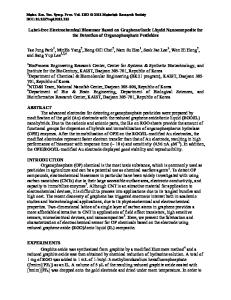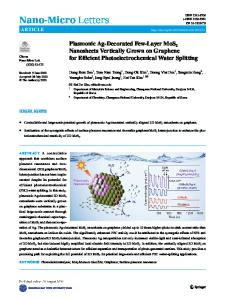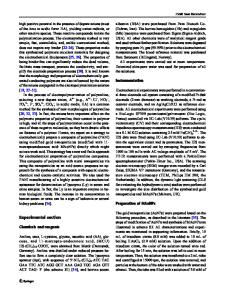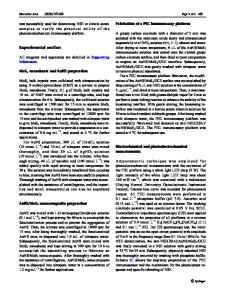An electrochemical DNA biosensor based on nitrogen-doped graphene nanosheets decorated with gold nanoparticles for genet
- PDF / 3,084,162 Bytes
- 8 Pages / 595.276 x 790.866 pts Page_size
- 87 Downloads / 350 Views
ORIGINAL PAPER
An electrochemical DNA biosensor based on nitrogen-doped graphene nanosheets decorated with gold nanoparticles for genetically modified maize detection Fuli Liu 1 & Kai Li 2 & Yukun Zhang 1 & Jiaqi Ding 1 & Tingting Wen 1 & Xinwu Pei 3 & Yongliang Yan 3 & Wei Ji 1 & Jian Liu 1 & Xiao Zhang 1 & Liang Li 3 Received: 21 May 2020 / Accepted: 18 August 2020 # Springer-Verlag GmbH Austria, part of Springer Nature 2020
Abstract A reliable electrochemical biosensor is reported based on nitrogen-doped graphene nanosheets and gold nanoparticle (Au/N-G) nanocomposites for the event-specific detection of GM maize MIR162. The differential pulse voltammetry response of methylene blue (MB) was chosen to monitor the target DNA hybridization event. Under the optimum conditions, the peak current increased linearly with the logarithm of the concentration of DNA in the range 1.0 × 10−14 to 1.0 × 10−8 M, and the detection limit was 2.52 × 10−15 M (S/N = 3). It is also demonstrated that the DNA biosensor has high selectivity, good stability, and fabrication reproducibility. The biosensor has been effectively applied to detect MIR162 in real samples, showing its potential as an effective tool for GM crop analysis. These results will contribute to the development of new portable transgenic detection systems. Keywords Genetically modified crops . Electrochemical biosensor . Nitrogen-doped graphene . Gold nanoparticles . Portable detection
Introduction According to the report of the International Service for the Acquisition of Agri-biotech Applications (ISAAA), 191.7 million hectares of biotech crops were grown in 26 countries worldwide in 2018, increasing ~ 113-fold from 1996 [1]. Electronic supplementary material The online version of this article (https://doi.org/10.1007/s00604-020-04511-4) contains supplementary material, which is available to authorized users. * Jian Liu [email protected] * Xiao Zhang [email protected] * Liang Li [email protected] 1
School of Life Science and Technology, Changchun University of Science and Technology, Changchun 130000, People’s Republic of China
2
College of Food Science and Nutritional Engineering, China Agricultural University, Beijing 100083, People’s Republic of China
3
Biotechnology Research Institute, Chinese Academy of Agricultural Sciences, Beijing 100081, China
MIR162 is an insect-resistant GM maize event developed by Syngenta that contains a single copy of the modified vip3A gene and a mannose-6-phosphate isomerase (pmi) gene [2, 3]. In October 2013, the Shenzhen Port of China detected MIR162 GM maize that was not approved by the Ministry of Agriculture in a shipment of maize imported from the USA. As of February 2014, the amount of GM maize returned from China has exceeded 1.25 million tons, which has attracted widespread societal attention, and has obtained 43 approvals in 23 countries + EU 28 (counted as one). However, there is only one qualitative polymerase chain reaction (PCR) method for the detection of this event in China, and it is still necessary to develop
Data Loading...











